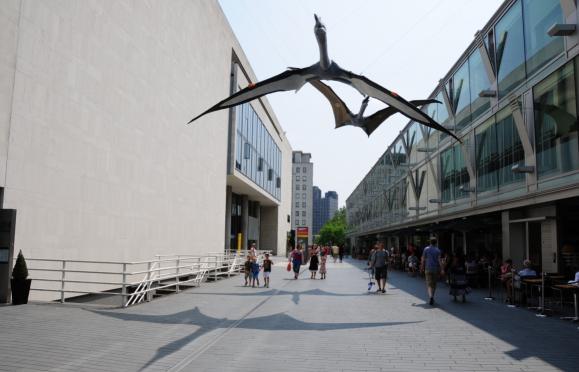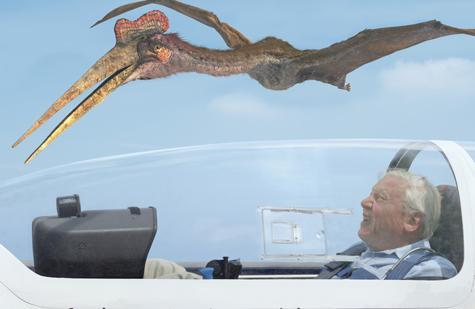Public engagement with evolutionary science: pterosaurs hit the big and little screen
Submitting Institution
University of PortsmouthUnit of Assessment
Earth Systems and Environmental SciencesSummary Impact Type
CulturalResearch Subject Area(s)
Biological Sciences: Biochemistry and Cell Biology, Genetics
Medical and Health Sciences: Neurosciences
Summary of the impact
Research on the anatomy, physiology and palaeoecology of pterosaurs by
the Palaeobiology Group at Portsmouth University has had a wide and
acknowledged impact, underpinning the creation and production of
block-buster and pioneering television and film productions worldwide. The
impact of this work is recognised by Sir David Attenborough, and by the
producers of such TV successes as Walking With Dinosaurs and
Flying Monsters 3D. These award-winning productions, highlighting
our work, have reached a global audience and supported the generation of
millions of pounds by the UK TV and film industry. Whilst the income
generated is highly significant, perhaps their greatest impact lies in
fostering a positive view of science, particularly in young audiences, by
bringing cutting-edge evolutionary science direct to the World's film and
TV screens.
Underpinning research
Our research tests hypotheses about the functional morphology,
palaeoecology and biogeography of pterosaurs using a combination of
physical modelling, flume tank experimentation, basic comparative anatomy
and mathematical modelling. The research has been undertaken by Drs
Martill, Witton and Naish, with minor input from collaborators in
Leicester and Sheffield. Within the scientific community our work, which
included the first functional analysis of the palaeobiology of giant
pterosaurs, is of interest to evolutionary biologists and vertebrate
palaeontologists. This work was undertaken between 1998 and the present
and led entirely by the University of Portsmouth group. It was coordinated
by Martill (Reader) as team leader who supervised the work of Naish (PhD
student and Res. Ass. to 2008) and Witton (PhD student and Post Doc. to
2011).
We investigated the mass of gigantic (~10 m) wingspan pterosaurs (ref.
1). In a new approach, the mass of the skeleton, muscle and viscera
was determined anatomically at ~250 kg for a ten metre wingspan pterosaur:
significantly higher than previously determined, and having considerable
effects on flight mechanics and stall speed. Witton and Naish (2008) then
evaluated the palaeoecology of giant pterosaurs, suggesting they were
analogous to modern storks (ref. 2). This study provided a novel
interpretation as azhdarchid pterosaurs were previously thought to have
been piscivorous oceanic gliders.
We also examined the hypothesis that pterosaurs fed by skimming (ref 3).
Such a feeding strategy is inefficient, requiring considerable energy
expenditure for limited resource capture. We combined calculated stall
speeds for pterosaurs previously considered to have been skim feeders, and
modelled the effects of skimming at speeds above this on water turbulence
and jaw strength in flume tanks. Our results excluded skimming for giant
pterosaurs. We determined a completely different lifestyle in which these
gigantic animals were dominantly terrestrial, and may have had an ecology
comparable to modern (though much smaller) ground hornbills and secretary
birds.
Many pterosaurs possess cranial crests located on the anterior rostrum,
posterior rostrum or both (ref. 4). The functionality of these is
controversial and includes possible involvement in thermoregulation,
species recognition and sexual selection. A primary function in flight
dynamics is considered unlikely, but a deleterious effect in flight
performance may be a trade off with sexual prowess. We analysed the growth
and development of a cranial crest in the genus Tupuxuara and
found that cranial crest development involves the growth of the premaxilla
over the cranium, including nasals, frontals and parietals, in progression
through ontogeny (ref. 5). This supports a behavioural function
rather than biomechanical.
The palaeobiology of prehistoric reptiles is derived entirely from
analysis of their fossil remains, and is severely limited by the
completeness of this record. New discoveries allow us to build on, or
challenge earlier ideas, while new methods of analysis such as CT
scanning, allow us to investigate aspects previously only studied using
destructive methodologies, or not studied at all. Our main findings have
overturned models of pterosaur life strategies (refs 2 and 4). We
have demonstrated that some achieved a wingspan >9m, perhaps >11m (ref.
3), and we have demonstrated that larger forms were far heavier than
previously thought (ref. 2). These new estimates do not exclude
larger pterosaurs from being volant (ref. 6).
References to the research
2. Witton, M. and Naish, D. (2008) A reappraisal of azhdarchid
pterosaur functional morphology and palaeoecology. PLoS ONE 3(5): e2271,
DOI:10.1371/journal.pone.00022271
3. Humphries, S., Bonser, R., Witton, M. and Martill, D. (2007) Did
pterosaurs feed by skimming? Physical modelling and anatomical
evaluation of an unusual feeding method. PLoS Biology, 5 (8). e204.
DOI:10.1371/journal.pbio.0050204;
9 citations by Oct 2013.
4. Martill, D. M. and Naish, D. (2006) Cranial crest development
in the azhdarchoid pterosaur Tupuxuara with a review of the genus
and tapejarid monophyly. Palaeontology, 49, 925-941. DOI: 10.1111/j.1475-4983.2006.00575.x;
27 citations by Oct 2013.
5. Tomkins, J., LeBas, N., Witton, M., Martill, D. M. and Humphries,
S. (2010) Positive allometry and the prehistory of sexual selection.
The American Naturalist, 176 (2). pp. 141-148. DOI: 10.1086/653001;
13 citations by Oct 2013.
6. Witton, M. P. and Habib, M. B. (2010) On the size and flight
diversity of giant pterosaurs, the use of birds as pterosaur analogues and
comments on pterosaur flightlessness. PLoS ONE, 5, e13982. doi: 10.1371/journal.pone.0013982
References 3,4,5 should be used to assess the quality of the research.
Reference 3 used novel stall speed calculations and flume tank experiments
to determine a completely different lifestyle for pterosaurs. The paper
has been well-cited for the research field and viewed online 8717 times
with 1749 pdf downloads (as of Oct. 2013). Reference 4, published in the
leading palaeontology journal (IF 1.65), overturned existing models of
pterosaur cranial development and has been very well cited (top 25% within
Earth and Environmental Sciences). Reference 5 demonstrates a relationship
between crest growth and sexual maturity. It has been very well cited (top
10% within Earth and Environmental Sciences) and is published in a
highly-ranked (IF 4.55) journal.
Details of the impact
The dual impacts of this work lie in public engagement in evolutionary
science and in supporting the generation of more than $10 M income for the
UK TV and film industry.
Ever since the successful employment of modern CGI (computer generated
image) techniques in animating prehistoric reptiles, first in Steven
Speilberg's portrayal of Michael Crichton's Jurassic Park
(Universal Pictures 1993), and subsequently in the novel "documentary"
genre for Tim Hains' and Jasper James' Walking With Dinosaurs (BBC
1999), public interest in prehistoric reptiles, especially dinosaurs and
pterosaurs, has soared. Walking With Dinosuars "began a new genre
of TV programme, the animated documentary, from which there have been many
spinoffs. The scientific input from the Portsmouth team was a key element
of that success."1.
Since 2008, our work on pterosaurs has been directly incorporated into a
BBC1 TV series and two major film productions: Planet Dinosaur
(BBC1: 2011), Flying Monsters 3D (Sky 3D: 2011) and Walking
With Dinosaurs: the 3D movie (BBC, 20th Century Fox,
National Geographic: to be released Christmas 2013). Martill and/or Witton
were principal scientific consultants for these productions. In all of
these productions, the pterosaurs are animated with morphology and ecology
based directly on the work of the Portsmouth Group: the scientists
constructed the physical models which were then developed in CGI.
As documented below2, Sir David Attenborough has noted the
importance of this scientific work to such programmes: regarding Flying
Monsters, he states that `Dr Martill advised us throughout the
film's production and gave it great authority'. In a public
interview, Anthony Geffen, CEO Atlantic Productions, stated that "the CG
team worked for months with scientists"3. Planet Dinosaur,
a six-part TV series4 incorporates the terrestrialised ecology
of azhdarchid pterosaurs as proposed in research by the Portsmouth group.
These programmes have received worldwide critical and public acclaim, as
well as major commercial success. Planet Dinosaur received viewing
figures of more than 4 million for episode 1 and around 2.9 million for
subsequent episodes4,5. Flying Monsters 3D won awards
from BAFTA (the first-ever Specialist Factual at the 2011 British Academy
Television Awards) and the 2011 Jackson Hole Wildlife Film Festival (Best
3D Film) and is believed to have been one of the most successful
documentary films ever made. The film was first screened on Christmas day
2011 on Sky 3D and has since been screened worldwide.
Using computer animations based on our research, Flying Monsters 3D
was extremely successful ("Educational and fun" — Independent on Sunday;
"Young dinosaur addicts will love this.." The Times6,7). By
June 2013, the film had grossed $10,252,849 at the box office and is still
showing in 84 cinemas world-wide. Natural History museums around the world
(including the Smithsonian, the U.S. National Museum of Natural History
and the Shanghai Science and Technology Museum) have regularly screened
the film8. DVD sales figures (release date 07/11/2011) are not
available but are expected to be high. Walking With Dinosaurs 3D,
to be released Christmas 2013, is also expected to be a success.
In 2010 the Portsmouth team were invited to provide the "headline"
exhibit for the Royal Society's 350th Anniversary Exhibition at London's
Southbank9. Martill and Witton's remarkable reconstructions of
azhdarchid pterosaurs were suspended around the exhibition hall, providing
a dramatic focus for the events' 70,000 visitors10 and for
media coverage (Radio 4's Today programme covered the opening by
focussing on the "flying dinosaurs").
Whilst the $10M+ income generated by these documentaries for the UK TV
and film industry is highly significant, perhaps their greatest impact
lies in bringing cutting-edge evolutionary science direct to the World's
film and TV screens. Not only does this engage and inspire the next
generation of scientists, but it also impacts the worldwide
evolution/creationism debate and fosters a positive view of science,
particularly in young audiences. The contribution of the Portsmouth team
was to give these programmes the firm basis in state-of-the-art
palaeontological science they needed for the success of their novel
"documentary" format.
New restorations of azhdarchid pterosaurs exhibited on London's
Southbank in celebration of 350 years of the Royal Society. Photo taken
June 26, 2010, Southbank, London, by Mr Ben Rimmer. This restoration was
built by Martill and Witton and is based on their research.

Sir David Attenborough's glider is overtaken by the Portsmouth
University life restoration of Quetzalcoatlus northropi, a
gigantic azhdarchid pterosaur from the Cretaceous of Texas.

Sources to corroborate the impact
- Letter from CEO Wide-Eyed Entertainment and Producer: Walking with
Dinosaurs. Supports claim on Martill's importance to the novel
"documentary" genre of Walking With Dinosaurs (1999) and the 3-D movie
(released Christmas 2013): "Without doubt, the Portsmouth
vertebrate palaeontologists have had an important impact in prehistoric
documentary TV and film production, not only in the UK, but
internationally."
- Letter from the BBC's most prominent wildlife broadcaster and former
Director of Programming of BBC Television. Provides evidence for the
importance of Martill's work to the Flying Monsters programme, and for
the widespread public interest in this area of science.
-
http://library.creativecow.net/kaufman_debra/Flying-Monsters-3D/1
Source of Anthony Geffen's public quote about the work of the CGI
team with scientists.
-
http://www.bbc.co.uk/programmes/p00l4m6s.
Shows images of the Portsmouth models in Planet Dinosaur.
-
http://shareofvoice.wordpress.com/tag/planet-dinosaur-uk-viewing-figures/
Gives viewing figures for Planet Dinosaur.
-
http://www.youtube.com/watch?v=Qyf8v5bf-rA
Trailer for Flying Monsters.
-
http://www.flyingmonsters3dmovie.com/media-coverage/#1-reviews
Supports the claim of critical success of the "edutainment" animated
documentary Flying Monsters-3D
-
http://press.nationalgeographic.com/2013/05/08/flying-monsters-10-million-box-office-revenue/.
Provides evidence for $10M + worldwide revenue for Flying Monsters 3D
and on museum showings.
-
http://www.bbc.co.uk/news/10322177
Shows the Portsmouth University team's work on the Royal Society's
350th Anniversary exhibition at the South
Bank, London
-
http://royalsociety.org/uploadedFiles/Royal_Society_Content/stay-in-touch/inside-science/2010-11-08-Inside-Science.pdf
Link to Royal Society's "Inside Science" 350th
Anniversary Edition with exhibition audience numbers and an article
(p5) on the Portsmouth work.